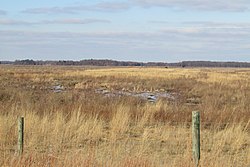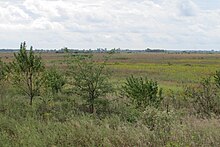| This article relies excessively on references to primary sources. Please improve this article by adding secondary or tertiary sources. Find sources: "Kankakee Sands" – news · newspapers · books · scholar · JSTOR (August 2021) (Learn how and when to remove this message) |
| Kankakee Sands | |
|---|---|
 Historic Beaver Lake area, drained in the early 1900s for farmland. Bogus Island in now the bison viewing area. Historic Beaver Lake area, drained in the early 1900s for farmland. Bogus Island in now the bison viewing area. | |
 | |
| Nearest city | Morocco, Indiana |
| Coordinates | 41°03′00″N 87°27′36″W / 41.05000°N 87.46000°W / 41.05000; -87.46000 |
| Established | 2016 |
| Governing body | The Nature Conservancy |
Kankakee Sands is a 10,000-acre (4,000 ha) complex of tallgrass prairie and oak savanna restorations and remnants in Kankakee County, Illinois and Newton County, Indiana. It is managed by The Nature Conservancy staff and volunteers. The Efroymson Restoration at Kankakee Sands is 8,400 acres (3,400 ha) of prairies and wetlands connecting Willow Slough Fish and Wildlife Area, Beaver Lake Nature Preserve, Conrad Savanna Nature Preserve and Conrad Station Savanna. This creates over 20,000 acres (8,100 ha) of dry, mesic and wet sand prairies, sand blows, sedge meadows, wetlands, and black oak savannas.
History

About 14,000 to 16,000 years ago, sands were deposited from glacial melt waters flowing from the retreating Laurentide ice sheet during the Wisconsin glaciation.
This area is part of the Grand Kankakee Marsh system and the site of the largest natural lake in Indiana until it was drained. Beaver Lake was 7 miles (11 km) long and 5 miles (8.0 km) wide. As a shallow lake, only 10 feet (3.0 m) deep, it was filled with vegetation and wildlife. It was drained by the 1880s. The Nature Conservancy purchased 7,200 acres (2,900 ha) of farmland in 1996 with the aim of restoring as a prairie.

Bison roamed through Indiana when the eastern pioneers first arrived in the state. Explorers reported bison in the 1600s and 1700s. An 1824 traveler encountered a single bison near the modern location of the preserve and shot it. Bison were extirpated from Indiana by 1830. Twenty-three American bison were introduced to the Kankakee Sands in October of 2016. The bison are from the Wind Cave National Park. Bison were indigenous to Indiana until exterminated by 1790.
Flora and fauna
The preserve supports a wide variety of plant and animal species. The bison provide management of the grasses on the prairie. They prefer grasses and sedges, leaving the flowering plants, which support a range of insects and animals. In addition, the bison, reduce the height of the plants, supporting ground dwelling birds. As of 2021 the bison herd had grown to more than 90 individuals.
- 772 plants: rattlesnake master (Eryngium yuccifolium), pricklypear cactus (Opuntia humifusa), beach wormwood (Artemisia caudata), roundheaded bush clover (Lespedeza capitata), Wild quinine (Parthenium integrifolium),
- Prairie: lead plant (Amorpha canescens), smooth blue aster (Symphyotrichum laeve), New Jersey tea (Ceanothus americanus), woodland sunflower (Helianthus divaricatus), rough blazing star (Liatris aspera), wild blue lupine (Lupinus perennis), downy phlox (Phlox pilosa), purple milkwort (Polygama polygama v. obtusata), bracken fern (Pteridium aquilinum latiusculum), Carolina rose (Rosa carolina), lanceleaf figwort (Scrophularia lanceolata), goat's rue (Tephrosia virginiana), lance leaved violet (Viola lanceolata).
- Sedges and grasses: little bluestem (Schizachyrium scoparium), Pennsylvania sedge (Carex pensylvanica),
- Trees: white oak (Quercus alba), black oak (Quercus velutina), sassafras (Sassafras albidum),
- Wet prairie: swamp milkweed (Asclepias incarnata), blue joint grass (Calamagrostis canadensis), fox sedge (Carex vulpinoidea), horsetail (Equisetum hyemale), blue flag iris (Iris virginica shrevei), cardinal flower (Lobelia cardinalis), great blue lobelia (Lobelia siphilitica), winged loosestrife (Lythrum alatum), hardstem bulrush (Scirpus acutus), green bulrush (Scirpus atrovirens), prairie cordgrass (Spartina pectinata)
- 68 butterflies: regal fritillary butterfly
- 153 bees
- 247 birds: Winter is the best time to see wintering owls and Rough-legged Hawks. From March thru June is best for seeing migrating and breeding prairie birds.
- Grasslands: American kestrel, bobolink, brown-headed cowbird, dickcissel, eastern meadowlark, eastern kingbird, field sparrow, grasshopper sparrow, Henslow's sparrow, horned lark, lark sparrow, mourning dove, northern bobwhite, ring-necked pheasant, Savannah sparrow, upland sandpiper, vesper sparrow
- Wetland-grasslands: American woodcock, common yellowthroat, Leconte's sparrow, marsh wren, Nelson's sharp-tailed sparrow, red-winged blackbird, sedge wren, swamp sparrow, yellow warbler, yellow-headed blackbird, Wilson's snipe
- Shrubs: alder flycatcher, American goldfinch, American tree sparrow, Bell's vireo, blue grosbeak, brown thrasher, eastern towhee, fox sparrow, golden-crowned kinglet, gray catbird, house wren, indigo bunting, loggerhead shrike, northern mockingbird, northern cardinal, orchard oriole, ruby-crowned kinglet, ruby-throated hummingbird, song sparrow, tree swallow, white-crowned sparrow, white-throated sparrow, willow flycatcher
- Ducks: blue-winged teal, bufflehead, Canada goose, common tern, gadwall, greater white-fronted goose, green-winged teal, hooded merganser, horned grebe, lesser scaup, mallard, mute swan, northern shoveler, northern pintail, redhead, ruddy duck, ring-necked duck, wood duck
- Marshes: American coot, American bittern, black rail, night-heron, great blue heron, great egret, green heron, king rail, least bittern, pied-billed grebe, sandhill crane, snowy egret, sora, tricolored heron, Virginia rail, white ibis, white-faced ibis, yellow rail
- Raptors: bald eagle, broad-winged hawk, merlin, peregrine falcon, red-shouldered hawk, rough-legged hawk, sharp-shinned hawk, Swainson's hawk, northern harrier, osprey, Cooper's hawk
- 9 snakes: e.g. milk snake, bull snake, hognose snake
- 2 lizards: e.g. six-lined racerunner, slender glass lizard
- 932 moths
- 10 amphibians: e.g. chorus frog, leopard frog, Fowler's toad, grey tree frog
- 33 mammals: e.g. plains pocket gopher
- 7 turtles: e.g. eastern box turtle
Other Nature Conservancy bison herds
The conservancy maintains a dozen herds through North and South Dakota, Nebraska, Iowa, Illinois, Colorado, Kansas, Missouri, and Oklahoma. Conservancy bison herds:
- Broken Kettle Grasslands, Iowa
- Joseph H. Williams Tallgrass Prairie, Oklahoma
- Dunn Ranch Prairie, Missouri
References
- "Visit Kankakee Sands". The Nature Conservancy. Retrieved August 28, 2021.
- ^ "Efroymson Restoration at Kankakee Sands | Overview". The Nature Conservancy. Archived from the original on June 24, 2021. Retrieved August 28, 2021.
- Phillippe, Loy R.; Molano-Flores, Brenda; Murphy, Michael J.C.; Marcum, Paul B.; Ebinger, John E. (2011). "Status of Endangered and Threatened Sand Area Species of the Illinois Flora". Illinois Natural History Survey Bulletin. 39 (4): 259–296. doi:10.21900/j.inhs.v39.103. hdl:2142/25989 – via CORE.
- Staff writer (August 29, 2017). "Bison at Kankakee Sands". South Shore Indiana, Visitor and Convention Authority. Retrieved November 6, 2021.
- Schneider, Karl (May 29, 2024). "Buffalo project helps restore prairie while reconnecting indigenous tribes with heritage". The Indianapolis Star. Retrieved May 29, 2024.
- Schneider, Karl (January 8, 2024). "Indiana preserve ramps up accessibility where buffalo restoration efforts take place". The Indianapolis Star. Retrieved January 8, 2025.
- Bowman, Dale (October 30, 2021). "Bison through the chute to their new home: Young bulls arrive and acclimate at Kankakee Sands". Chicago Sun-Times. Retrieved November 1, 2021.
- "Efroymson Restoration at Kankakee Sands | Bison at Kankakee Sands". The Nature Conservancy. Archived from the original on June 24, 2021. Retrieved August 28, 2021.
- "Bison at Kankakee Sands". South Shore Convention & Visitors Authority. 2021. Archived from the original on April 15, 2021. Retrieved July 12, 2021.
- Welcome to the Grace Teninga Discover Trail, Efroymson Restoration at Kankakee Sands; The Nature Conservancy; undated
- Staff writer. "Northwest Indiana Birding Opportunities - Kankakee Sands Nature Conservancy". Indiana Birding Trail. Indiana Audubon Society. Retrieved November 6, 2021.
- ^ "Efroymson Restoration at Kankakee Sands | Animals at the Kankakee Sands | Birds". The Nature Conservancy. Archived from the original on June 24, 2021. Retrieved August 28, 2021.